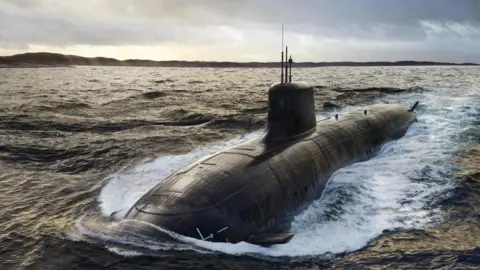The UK government is positioning itself for a significant enhancement in its naval defense capabilities, as highlighted by an impending announcement regarding the construction of up to 12 new attack submarines. This initiative, which will be officially unveiled by Prime Minister Sir Keir Starmer, forms part of a comprehensive defense review scheduled for Monday. This extensive assessment seeks to address the challenges posed by evolving global threats and reaffirms the UK’s commitment to maintaining strong maritime defenses.
The new submarines will feature advanced capabilities and are set to replace the existing fleet of seven Astute-class submarines, which have been operational since their introduction in the late 2030s. These new vessels will be conventionally armed but capable of nuclear propulsion, showcasing a blend of modern technology and strategic military planning. The government’s focus on bolstering the Royal Navy’s submarine fleet reflects an understanding of the rising geopolitical tensions, particularly with nations like Russia, which have accentuated security concerns across Europe.
In addition to the submarine program, the government plans to announce an expenditure of £15 billion dedicated to updating its nuclear warhead arsenal. This investment aims to reinforce the UK’s continuous-at-sea deterrent system, particularly vital for the country’s defense posture in an increasingly volatile world. The emphasis on maintaining and upgrading nuclear capabilities indicates a broader strategy to ensure that the UK remains a formidable military force as it adapts to contemporary challenges.
This defense review, pivotal in shaping the future of the UK armed forces, will encompass a range of recommendations — totaling 62 — aimed at the overall strategic posture of the military. These recommendations, anticipated to be fully accepted by the government, will argue for a transition to “warfighting readiness.” Enhancing combat readiness is deemed essential to counter the aggressive maneuvers exhibited by adversaries and to uphold the security of the UK and its allies in NATO.
Sir Keir Starmer has been vocal about the realities posed by threats from Russia, asserting that the danger cannot be overlooked. During an interview with BBC Radio 4’s Today programme, he articulated the notion that preparing for conflict is the most effective means of deterrence. The strategic review underscores this belief by advocating for a united front among NATO allies, enhancing collaborative defense mechanisms to optimize regional security.
The discourse surrounding the UK’s defense budget is also evolving. The government has pledged to increase defense spending from 2.3% to 2.5% of national income by 2027, a decision welcomed across political lines. However, there remains a heated debate regarding reaching a target of 3% of GDP allocated to defense spending, with various political factions asserting contrasting timelines. The ruling government aims to reach this new benchmark by 2034, while the Conservatives and opposition parties demand a more immediate commitment to bolstering military financing.
Complications in political unity over defense spending timelines were highlighted by Labour’s position regarding future funding. Shadow Defense Secretary James Cartlidge expressed caution regarding Labour’s ambitious plans for defense, stipulating that concrete financial frameworks should accompany commitments to spending on new military initiatives, particularly those concerning submarines. The Liberal Democrats further challenge Labour’s 2034 spending timeline, calling for more immediate discourse on financial support to undergird the announced projects.
Moreover, the report on defense will elucidate several ancillary projects, including a £1.5 billion commitment to establish new munitions factories, developing long-range weaponry such as missiles and drones, and the creation of a specialized cyber command to enhance defensive and offensive cyber capabilities for the military.
As the Ministry of Defence continues to advance the naval protection capabilities, transitioning from the Astute-class submarines to the SSN-AUKUS class will exemplify a strategic modernization effort in response to contemporary threats. The integration of advanced technology within maritime warfare will serve both the UK’s interests and bolster NATO’s collective defense strategy, reinforcing a united stance against potential aggressors in the global arena. This transformative phase in the UK’s defense landscape promises to significantly impact national and allied security for decades to come.










